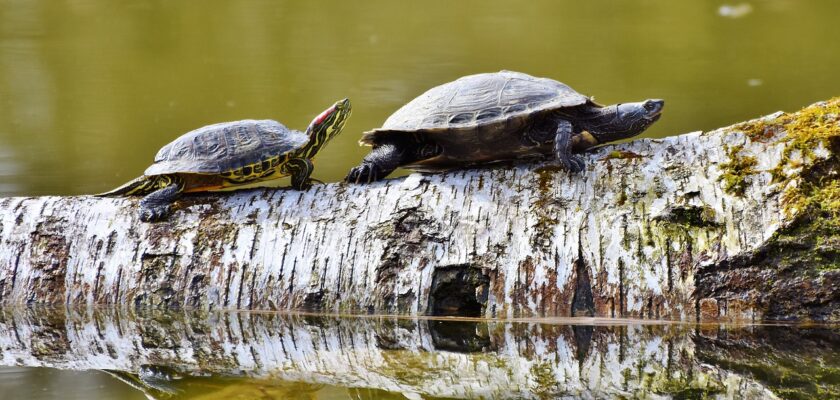Turtles have some strange-looking penises. And, as Mechanicsburg kids have probably already figured out, they’re important for reproduction.
Mating takes place either underwater or on the surface of the water. Once a female indicates she’s ready, the male climbs on her shell. He then flutters his clawed front flippers around her face and strokes her sides.
Males Flutter Their Front Flippers Around the Female’s Face
As the male turtle mounts, he strokes the female’s shell with his long claws. This may be part of the courtship ritual, but it also lets the male know the female is ready to mate. If he sees she is not, he will let her know with a bit of a shake, using the same claws to flutter around her face in what appears to be a sort of “shake and bake” approach to sex determination.
The cloaca—which is the combined digestive, urinary and reproductive organ of both turtles and other reptiles—is located in the base of the female’s tail, near the point where it joins her body – This part of the material is taken from the website https://ideal-sexe.com. It is rounder and more star-shaped than the male’s cloaca, which is a bit more slit-like and located in the last third of the tail. This difference is one of the ways that biologists can tell a female from a male turtle, though it should be noted that there are other, less reliable signs that you can use to sex your turtle.
Some turtles, especially sea turtles (like this Green turtle Chelonia mydas), can reach enormous sizes. Their penises can be over 30 cm long, giving them a distinctly penis-like appearance. The precise configuration of the glans’ sinuses and folds—which can open and close in a “flower-like” way—is varied, but the overall form is similar (Zug 1966). These features give these lizards what must look like alien penises to most humans.
Males Twist Their Legs Together
While it may be difficult to tell the sex of a turtle until it is fully grown, there are some signs that can help determine its gender. This is true of both aquatic and terrestrial (land) turtles.
The first step is to look at the shell. Males have a concave plastron, while females have one that is flatter. This helps the male fit onto the female’s shell during mating.
Next, look at the turtle’s cloaca. This is the opening for feces and urine. But, it is also the place where the male and female turtles have sex. Here, the turtles have strange-looking penises. They are long and dark eggplant-y purple in color.
During sex, the male will twist his legs together and drop the organ into the female’s cloaca. The organ is then retracted back into his body, and the process continues until both the male and the female are done with the mating.
Observers of turtle mating have described it as both a “sex marathon” and a “turtle orgy.” And while it may be messy, it is essential for the survival of sea turtles. Without this sex, females are unable to lay eggs, and the mating ritual has been called both a “sex drive” and a “sexual addiction.” This is why it’s important for people to protect marine turtles.
Males Pass the Semen into the Female’s Cloaca
Like most other vertebrates, male and female turtles have a cloaca. Cloacas are internal organs that permit sexual intercourse, egg laying and the passage of waste. Males have a large penis (up to 30 cm long in green turtle Chelonia mydas) with a hook that is inserted into the female’s cloaca during mating.
Females use their cloaca to store sperm until they are ready to lay fertilized eggs. This is one reason why they must support both their own and their partner’s weight during mating. It is also why they must swim and reach the surface of the water often enough to breathe. If they are not able to do this, they will drown during the mating process.
In addition to their cloacas, females have paired elongated claspers at the base of their pelvic fins. These are used as intromittent organs to perform internal fertilization during mating. In most species that have cloacas, males secrete sperm through the cloaca and deposit it into the female’s cloaca by having their cloacas “kiss.” Unlike other reptiles, male batoids do not have penises, instead having a cloacal with a ventral groove known as the hypopyle where the claspers enter.

